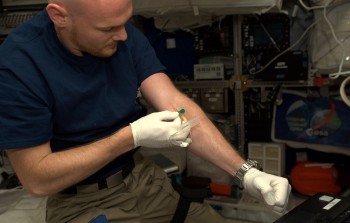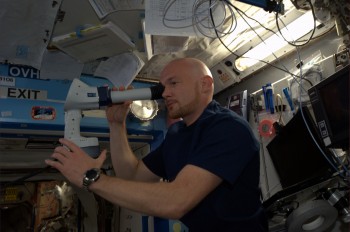The mission for Alexander Gerst and his crew-mates is now going full steam ahead. You may think the crew members are given plenty of time to relax and to get used to their new home. But mmm …. not really … from a scientific perspective, many activities need to be completed in the first weeks.
Especially for human research, it is important to obtain data early on to capture the status of physiological systems of the human body and the effect of microgravity immediately after the astronauts reach their new environment.
Already in their first week, Alexander and his colleagues have been taking blood, saliva, body and perspiration samples for several human research investigations they participate in. In addition, the crew members have been filling in questionnaires and doing different types of body scans.
In-flight visual changes, the immune system and susceptibility to infections, the collection of microbes in and on the human body, occurrences of headaches (Space Headaches), and several indicators of health (called biomarkers) have all already been investigated in their first week on-board.
It is not easy to make scientific conclusions on the human body. We are all different. And we also feel different at different times. So identifying what is the exact impact of a new environment such as space weightlessness on a sub-system of the human body needs to be done very meticulously.
For each investigation, we need to collect data from many different test subjects to deduce scientific results that are not just valid for one person but will tell us something on how microgravity impacts the human body in general.
For many investigations, every crew member needs to collect the same type of data or samples multiple times during their flight. This allows us to see how their bodies change over time. It is now a well-established fact that human sub-systems adapt to weightlessness in different ways.
We also need enough data from crew members on Earth to compare to. You may think that Alexander’s mission started 28 May 2014, but data collection started many months before and will continue for many months afterwards.
The first week on the Space Station for Alexander and his crewmates was a busy one, but even the long list of activities they performed is only the tip of the iceberg. In these blogs, we will try to tell some stories related to Alexander’s science mission and show some aspects below the waterline of the impressive iceberg that is the International science programme of the Blue Dot mission.
ESA Mission Science Office






Discussion: one comment
Love reading your blogs and pictures on facebook Alex. My son is wondering if NASA is gonna send humans to Mars. Thanks again for making space not a far flung concept but real with people and pictures. Space, active vulcano and ice caves, skydiving , your fb pictures do have a difference than usual kids, pets and funny comments! Once your space mission is over Alex, could you come to New Zealand and tell us all about it? Viele Grusse from Brett, Kitty, Martin Eric and Natasha Parker